Energy Renovation versus Demolition and Construction of a New Building—A Comparative Analysis of a Swedish Multi-Family Building
Abstract
1. Introduction
2. Renovation and Building Costs in a Swedish Context
2.1. Renovation
2.2. New Construction
3. Case Description
3.1. Reference Building
3.2. Typical Building Types
4. Methodological Approach
4.1. LCC Optimal Energy Renvoation
Cost of Renovation Measures
4.2. LCC of Newly Constructed Building
Demolition and Construction Costs
4.3. Calculation of Space Heating Demand and Heating Costs
District Heating Tariffs
4.4. Comparison between Renvoation and Demolition and Construction of New Building
5. Results and Analysis
5.1. Life Cycle Costs of Renovation
Comparison with Other Renovation Projects
5.2. Cost of Demolition and the Construction of a New Building
5.3. Comparison between the Renovation and the Construction of a New Building
6. Discussion
7. Conclusions
Author Contributions
Funding
Acknowledgments
Conflicts of Interest
References
- European Commission. EU Energy Statistical Pocketbook and Country Datasheets|Energy. Available online: https://ec.europa.eu/energy/en/data/energy-statistical-pocketbook (accessed on 10 June 2019).
- Gynther, L.; Lapillonne, B.; Pollier, K. Energy Efficiency Trends and Policies in the Household and Tertiary Sectors—An Analysis Based on the ODYSSEE and MURE Databases. Available online: http://www.odyssee-mure.eu/publications/br/energy-efficiency-trends-policies-buildings.pdf (accessed on 10 June 2019).
- European Commission. Energy Performance of Buildings. Available online: https://ec.europa.eu/energy/en/topics/energy-efficiency/buildings (accessed on 10 June 2019).
- European Parliament. Directive 2010/31/EU of the European Parliament and of the Council—on the Energy Performance of Buildings. Available online: https://eur-lex.europa.eu/legal-content/EN/TXT/?uri=CELEX%3A32010L0031 (accessed on 10 June 2019).
- Lechtenböhmer, S.; Schüring, A. The potential for large-scale savings from insulating residential buildings in the EU. Energy Effic. 2011, 4, 257–270. [Google Scholar] [CrossRef]
- Morelli, M.; Rønby, L.; Mikkelsen, S.E.; Minzari, M.G.; Kildemoes, T.; Tommerup, H.M. Energy retrofitting of a typical old Danish multi-family building to a “nearly-zero” energy building based on experiences from a test apartment. Energy Build. 2012, 54, 395–406. [Google Scholar] [CrossRef]
- Liu, L.; Moshfegh, B.; Akander, J.; Cehlin, M. Comprehensive investigation on energy retrofits in eleven multi-family buildings in Sweden. Energy Build. 2014, 84, 704–715. [Google Scholar] [CrossRef]
- Popescu, D.; Bienert, S.; Schützenhofer, C.; Boazu, R. Impact of energy efficiency measures on the economic value of buildings. Appl. Energy 2012, 89, 454–463. [Google Scholar] [CrossRef]
- Ferreira, M.; Almeida, M.; Rodrigues, A. Impact of co-benefits on the assessment of energy related building renovation with a nearly-zero energy target. Energy Build. 2017, 152, 587–601. [Google Scholar] [CrossRef]
- Thomsen, K.E.; Rose, J.; Mørck, O.; Jensen, S.Ø.; Østergaard, I.; Knudsen, H.N.; Bergsøe, N.C. Energy consumption and indoor climate in a residential building before and after comprehensive energy retrofitting. Energy Build. 2016, 123, 8–16. [Google Scholar] [CrossRef]
- Prasauskas, T.; Martuzevicius, D.; Kalamees, T.; Kuusk, K. Effects of Energy Retrofits on Indoor Air Quality in Three Northern European Countries. Energy Procedia 2016, 96, 253–259. [Google Scholar] [CrossRef]
- Liu, L.; Rohdin, P.; Moshfegh, B. Evaluating indoor environment of a retrofitted multi-family building with improved energy performance in Sweden. Energy Build. 2015, 102, 32–44. [Google Scholar] [CrossRef]
- Mørck, O.; Almeida, M.; Ferreira, M.; Brito, N.; Thomsen, K.E.; Østergaard, I. Shining examples analysed within the EBC Annex 56 project. Energy Build. 2016, 127, 991–998. [Google Scholar] [CrossRef]
- Kuusk, K.; Kalamees, T.; Link, S.; Ilomets, S.; Mikola, A. Case-study analysis of concrete large-panel apartment building at pre- and post low-budget energy-renovation. J. Civ. Eng. Manag. 2017, 23, 67–75. [Google Scholar] [CrossRef]
- Blomqvist, S.; La Fleur, L.; Amiri, S.; Rohdin, P.; Ödlund, L. The impact on system performance when renovating a multifamily building stock in a district heated region. Sustainability 2019, 11, 2199. [Google Scholar] [CrossRef]
- La Fleur, L.; Rodhin, P.; Moshfegh, B. Energy use and perceived indoor environment in a Swedish multifamily building before and after major renovation. Sustainability 2018, 10, 766. [Google Scholar] [CrossRef]
- Wrålsen, B.; O’Born, R.; Skaar, C. Life cycle assessment of an ambitious renovation of a Norwegian apartment building to nZEB standard. Energy Build. 2018, 177, 197–206. [Google Scholar] [CrossRef]
- Friesen, C.; Malbert, B.; Nolmark, H. Renovating to Passive Housing in the Swedish Million Programme. Plan. Theory Pract. 2012, 13, 115–131. [Google Scholar] [CrossRef]
- Gluch, P.; Baumann, H. The life cycle costing (LCC) approach: A conceptual discussion of its usefulness for environmental decision-making. Build. Environ. 2004, 39, 571–580. [Google Scholar] [CrossRef]
- Liu, L.; Rohdin, P.; Moshfegh, B. LCC assessments and environmental impacts on the energy renovation of a multi-family building from the 1890s. Energy Build. 2016, 133, 823–833. [Google Scholar] [CrossRef]
- Milić, V.; Ekelöw, K.; Moshfegh, B. On the performance of LCC optimization software OPERA-MILP by comparison with building energy simulation software IDA ICE. Build. Environ. 2017. [Google Scholar] [CrossRef]
- Spickova, M.; Myskova, R. Costs Efficiency Evaluation using Life Cycle Costing as Strategic Method. Procedia Econ. Financ. 2015, 34, 337–343. [Google Scholar] [CrossRef]
- Brown, N.W.O.; Malmqvist, T.; Bai, W.; Molinari, M. Sustainability assessment of renovation packages for increased energy efficiency for multi-family buildings in Sweden. Build. Environ. 2013, 61, 140–148. [Google Scholar] [CrossRef]
- Almeida, M.; Ferreira, M. Cost effective energy and carbon emissions optimization in building renovation (Annex 56). Energy Build. 2017, 152, 718–738. [Google Scholar] [CrossRef]
- Niemelä, T.; Kosonen, R.; Jokisalo, J. Cost-effectiveness of energy performance renovation measures in Finnish brick apartment buildings. Energy Build. 2017, 137, 60–75. [Google Scholar] [CrossRef]
- Liu, L.; Rohdin, P.; Moshfegh, B. Investigating cost-optimal refurbishment strategies for the medieval district of Visby in Sweden. Energy Build. 2018, 158, 750–760. [Google Scholar] [CrossRef]
- Tokarik, M.S.; Richman, R.C. Life cycle cost optimization of passive energy efficiency improvements in a Toronto house. Energy Build. 2016, 118, 160–169. [Google Scholar] [CrossRef]
- Murray, S.N.; Walsh, B.P.; Kelliher, D.; O’Sullivan, D.T.J. Multi-variable optimization of thermal energy efficiency retrofitting of buildings using static modelling and genetic algorithms—A case study. Build. Environ. 2014, 75, 98–107. [Google Scholar] [CrossRef]
- Kuusk, K.; Kalamees, T.; Maivel, M. Cost effectiveness of energy performance improvements in Estonian brick apartment buildings. Energy Build. 2014, 77, 313–322. [Google Scholar] [CrossRef]
- Itard, L.; Klunder, G. Comparing environmental impacts of renovated housing stock with new construction. Build. Res. Inf. 2007, 35, 252–267. [Google Scholar] [CrossRef]
- Verbeeck, G.; Cornelis, A. Renovation versus demolition of old dwellings Comparative analysis of costs, energy consumption and environmental impact. In Proceedings of the PLEA2011—27th International conference on Passive and Low Energy Architecture, Louvain-la-Neuve, Belgium, 13–15 July 2011; pp. 1–6. [Google Scholar]
- Power, A. Does demolition or refurbishment of old and inefficient homes help to increase our environmental, social and economic viability? Energy Policy 2008, 36, 4487–4501. [Google Scholar] [CrossRef]
- Power, A. Housing and sustainability: Demolition or refurbishment? Urban Des. Plan. 2010, 163, 205–216. [Google Scholar] [CrossRef]
- Weiler, V.; Harter, H.; Eicker, U. Life cycle assessment of buildings and city quarters comparing demolition and reconstruction with refurbishment. Energy Build. 2017, 134, 319–328. [Google Scholar] [CrossRef]
- Ferreira, J.; Duarte Pinheiro, M.; De Brito, J. Economic and environmental savings of structural buildings refurbishment with demolition and reconstruction—A Portuguese benchmarking. J. Build. Eng. 2015, 3, 114–126. [Google Scholar] [CrossRef]
- Morelli, M.; Harrestrup, M.; Svendsen, S. Method for a component-based economic optimisation in design of whole building renovation versus demolishing and rebuilding. Energy Policy 2014, 65, 305–314. [Google Scholar] [CrossRef]
- Alba-Rodríguez, M.D.; Martínez-Rocamora, A.; González-Vallejo, P.; Ferreira-Sánchez, A.; Marrero, M. Building rehabilitation versus demolition and new construction: Economic and environmental assessment. Environ. Impact Assess. Rev. 2017, 66, 115–126. [Google Scholar] [CrossRef]
- Sadick, A.; Issa, M.H. Differences in teachers’ satisfaction with indoor environmental quality and their well-being in new, renovated and non-renovated schools. Indoor Built Environ. 2018, 27, 1272–1286. [Google Scholar] [CrossRef]
- Bullen, P.A.; Love, P.E.D. The rhetoric of adaptive reuse or reality of demolition: Views from the field. Cities 2010, 27, 215–224. [Google Scholar] [CrossRef]
- Bullen, P.; Love, P. A new future for the past: A model for adaptive reuse decision-making. Built Environ. Proj. Asset Manag. 2011, 1, 32–44. [Google Scholar] [CrossRef]
- Swedish Association of Public Housing Companies; Fastigehetsägarna (Swedish Assisiation for Property Owners); Swedish Union of Tenants. Att Arbeta med Hyressättningsmodeller—En Handledning för Systematisk Hyressättning. Available online: https://www.sabo.se/trycksaker/att-arbeta-med-hyressattningsmodeller/ (accessed on 10 June 2019).
- Lind, H. Leder Hyreslagens Regler Till Rätt Renoveringar: Analys och Förslag; Building and Real Estate Economics, Real Estate and Construction Management, School of Architecture and the Built Environment (ABE), KTH: Stockholm, Sweden, 2015. [Google Scholar]
- Byman, K.; Jernelius, S. Ekonomi vid Ombyggnader med Energisatsningar. Stockholm, Sweden, 2012. Available online: https://insynsverige.se/documentHandler.ashx?did=96754 (accessed on 10 June 2019).
- Martinsson, L. Uvärdering av prefabricerad vägg—System för tilläggsisolering vid renovering av flerbostadshus Byggbarhet i produktion Prefab i renovering. 2014. Available online: https://www.bebostad.se/library/1846/utvaerdering-av-prefabricerad-vaegg-slutrapport.pdf (accessed on 10 June 2019).
- Statistics Sweden Priser för Nyproducerade Bostäder. Available online: https://www.scb.se/hitta-statistik/statistik-efter-amne/boende-byggande-och-bebyggelse/byggnadskostnader/priser-for-nyproducerade-bostader/ (accessed on 17 December 2018).
- BeBo Brogården—Passivhusrenovering. Available online: http://www.bebostad.se/library/1777/godaex-brogaarden-2014.pdf (accessed on 17 December 2018).
- BeBo Backa Röd—Lågenergirenovering. Available online: http://www.bebostad.se/library/1776/godaex-backa-roed-2014.pdf (accessed on 17 December 2018).
- Swedish National Board of Housing Building and Planning. Produktionskostnader för nyproduktion av flerbostadshus; Swedish National Board of Housing Building and Planning: Karlskrona, Sweden, 2009; ISBN 9789186045555.
- Wikells Byggberäkningar AB Kalkylprogram och kalkylböcker inom Bygg, El och VVS—Wikells Byggberäkningar. Available online: http://www.wikells.se/omwikells.aspx (accessed on 10 June 2019).
- La Fleur, L.; Moshfegh, B.; Rohdin, P. Measured and predicted energy use and indoor climate before and after a major renovation of an apartment building in Sweden. Energy Build. 2017, 146, 98–110. [Google Scholar] [CrossRef]
- International Standard ISO 6946:2007. Building Components and Building Elements—Thermal Resistance and Thermal Transmittance—Calculation Method 2007. Available online: https://www.iso.org/standard/40968.html (accessed on 11 June 2019).
- International Standard ISO 13370:2007. Thermal Performance of Buildings—Heat Transfer via the Ground—Calculation Methods 2007.
- Adalberth, K.; Wahlström, Å.; Abel, E.; Tućan, B. Energibesiktning av byggnader: Flerbostadshus och Lokaler; SIS förlag: Stockholm, Sweden, 2009; ISBN 9789171627551. [Google Scholar]
- Sveby Brukarindata bostäder. Available online: http://www.sveby.org/ (accessed on 10 June 2019).
- Gustafsson, S.-I. Optimal Energy Retrofits on Existing Multi-Family Buildings; Linköping Studies in Science and Technology. Dissertation No. 0280-7971; Linköping University: Linköping, Sweden, 1986; ISBN 91-7870-118-X. [Google Scholar]
- Gustafsson, S.-I. Mixed integer linear programming and building retrofits. Energy Build. 1998, 28, 191–196. [Google Scholar] [CrossRef]
- Gustafsson, S.I. Optimal fenestration retrofits by use of MILP programming technique. Energy Build. 2001, 33, 843–851. [Google Scholar] [CrossRef]
- Gustafsson, S.I.; Bojic, M. Optimal heating-system retrofits in residential buildings. Energy 1997, 22, 867–874. [Google Scholar] [CrossRef]
- La Fleur, L.; Rohdin, P.; Moshfegh, B. Investigating cost-optimal energy renovation strategies for a multifamily building in Sweden. Energy Build. 2019. submitted. [Google Scholar]
- Equa Simulation AB. Validation of IDA Indoor Climate and Energy 4.0 Build 4 with Respect to ANSI/ASHRAE Standard 140-2004. Solna, Sweden, 2010. Available online: http://www.equaonline.com/iceuser/validation/ASHRAE140-2004.pdf (accessed on 10 June 2019).
- Equa Simulation AB. Validation of IDA Indoor Climate and Energy 4.0 with Respect to CEN Standards EN 15255-2007 and EN 15265-2007. Solna, Sweden, 2010. Available online: http://www.equaonline.com/iceuser/validation/CEN_VALIDATION_EN_15255_AND_15265.pdf (accessed on 10 June 2019).
- Kropf, S.; Zweifel, G. Validation of the Building Simulation Program IDA-ICE According to CEN 13791 “Thermal Performance of Buildings—Calculation of Internal Temperatures of a Room in Summer Without Mechanical Cooling—General Criteria and Validation Procedures”; Hochschule Technik+Architektur Luzern. HLK Engineering. 2001. Available online: http://www.equaonline.com/iceuser/validation/ICE_vs_prEN%2013791.pdf (accessed on 10 June 2019).
- Loutzenhiser, P.; Manz, H.; Maxwell, G. Empirical Validations of Shading/Daylighting/Load Interactions in Building Energy Simulation Tools; A Report from the International Energy Agency´s SHC Task 34/ECBCS Annex 42 Project C; International Energy Agency: Paris, France, 2007. [Google Scholar]
- Swedish National Board of Housing Building and Planning. The Swedish Building Code; Swedish National Board of Housing Building and Planning: Karlskrona, Sweden, 2018; ISBN 9789175635804.
- Swedish Association of Public Housing Companies SABOs Kombohus Plus. Available online: https://www.sabo.se/nyproduktion/sabo-kombohus/sabos-kombohus-plus/ (accessed on 16 January 2019).
- Skanska Kombohus. Available online: https://www.skanska.se/vart-erbjudande/byggentreprenader/byggkoncept/kombohus/ (accessed on 16 January 2019).
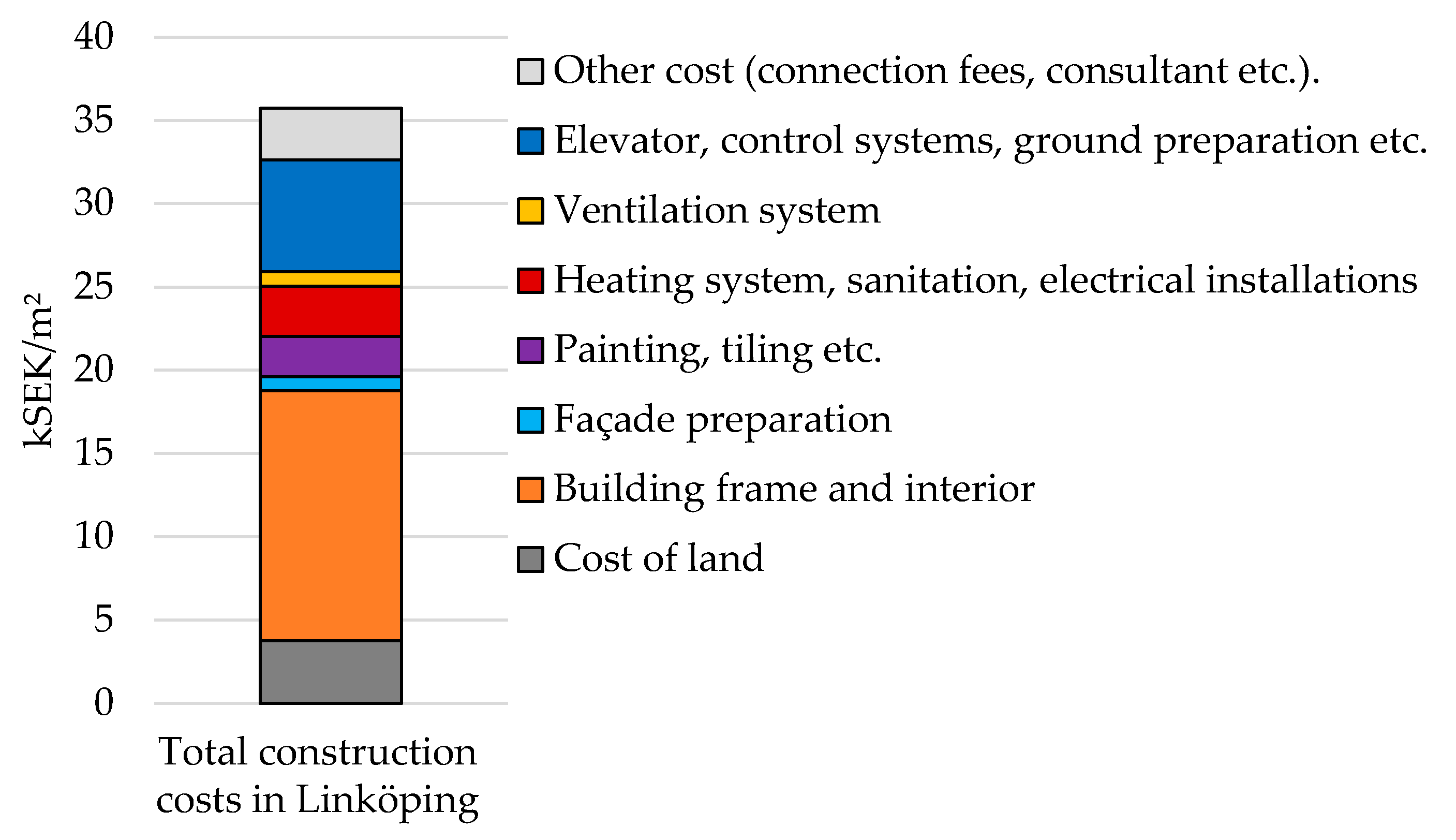
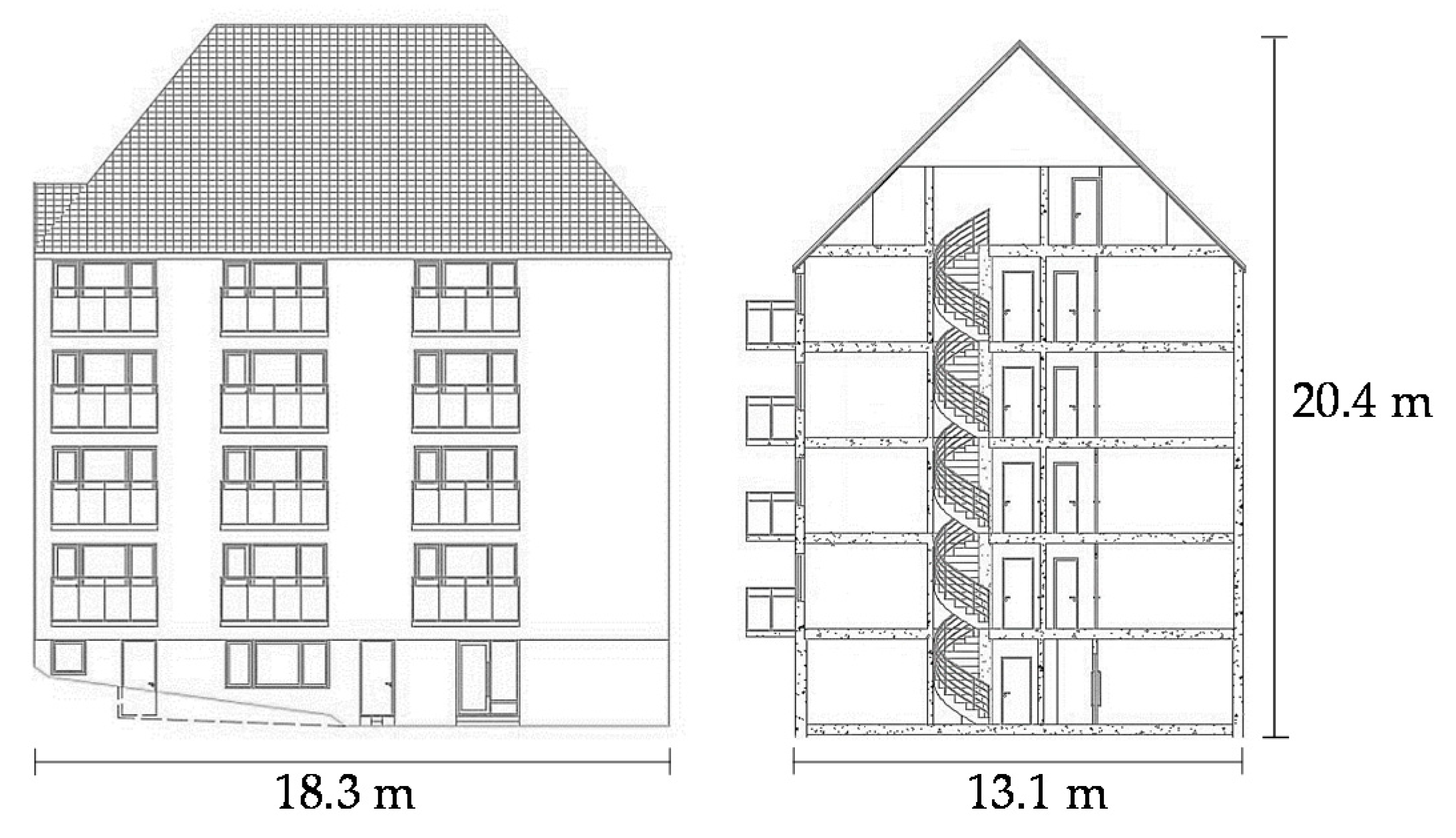

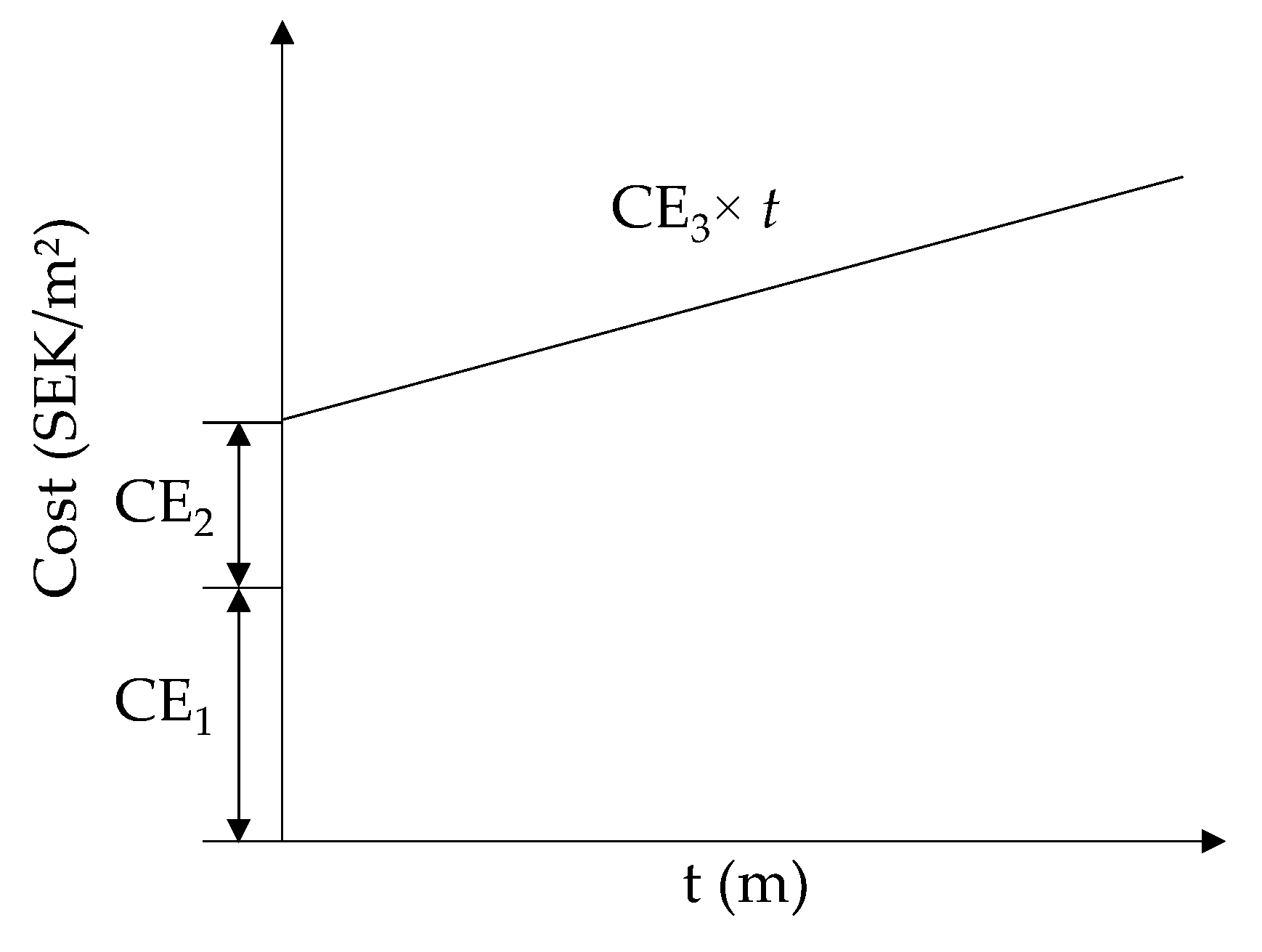
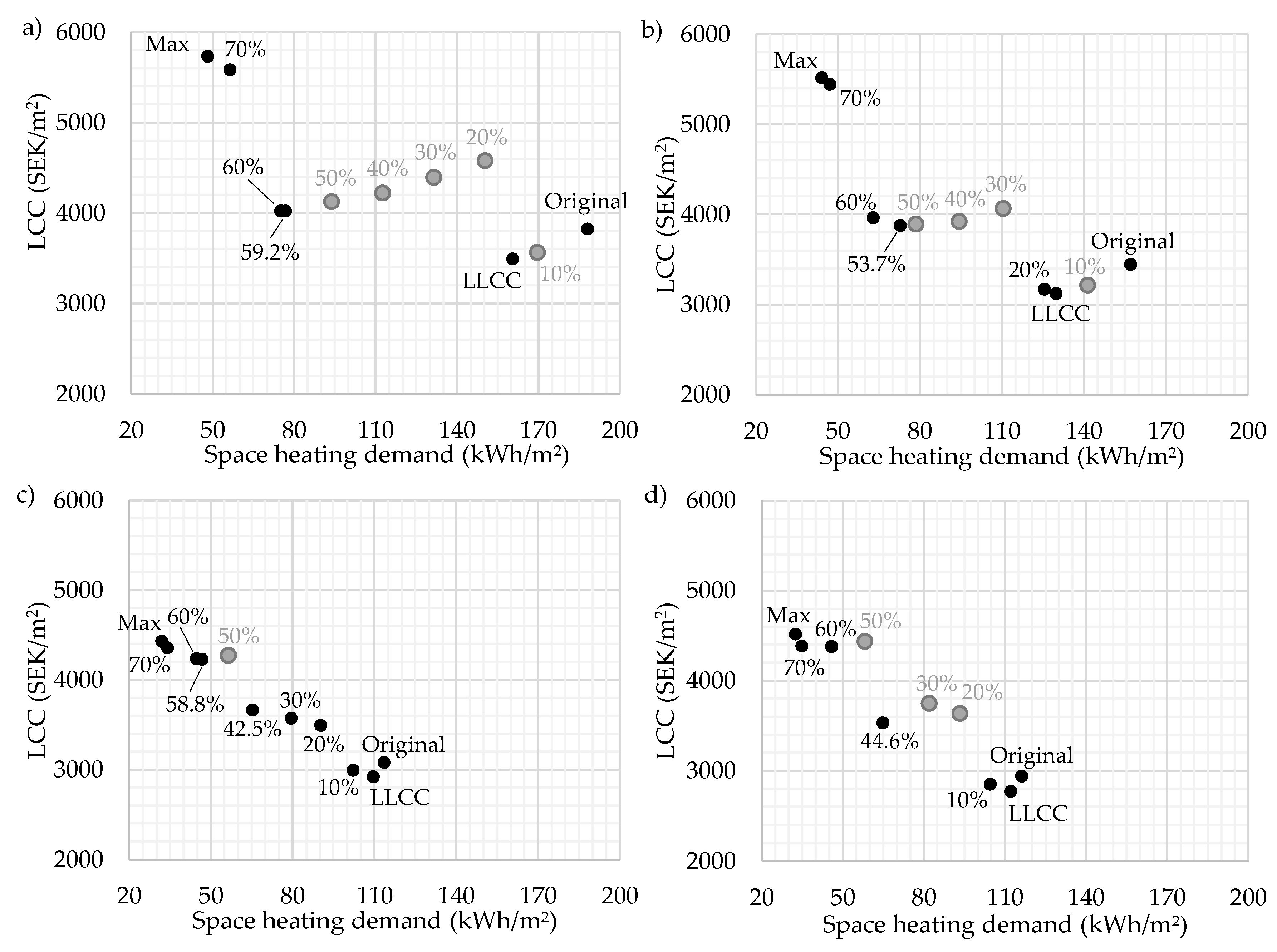
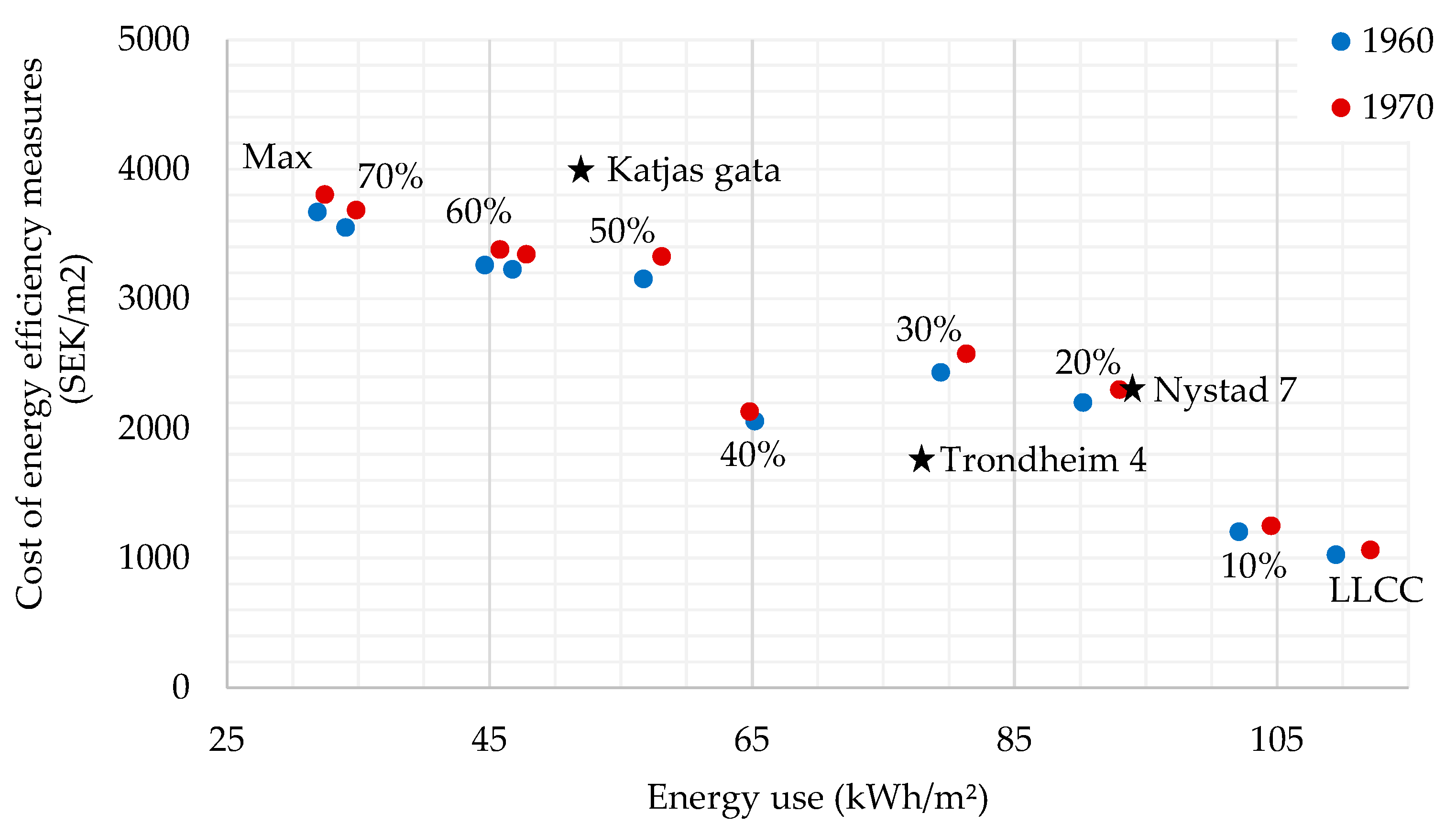
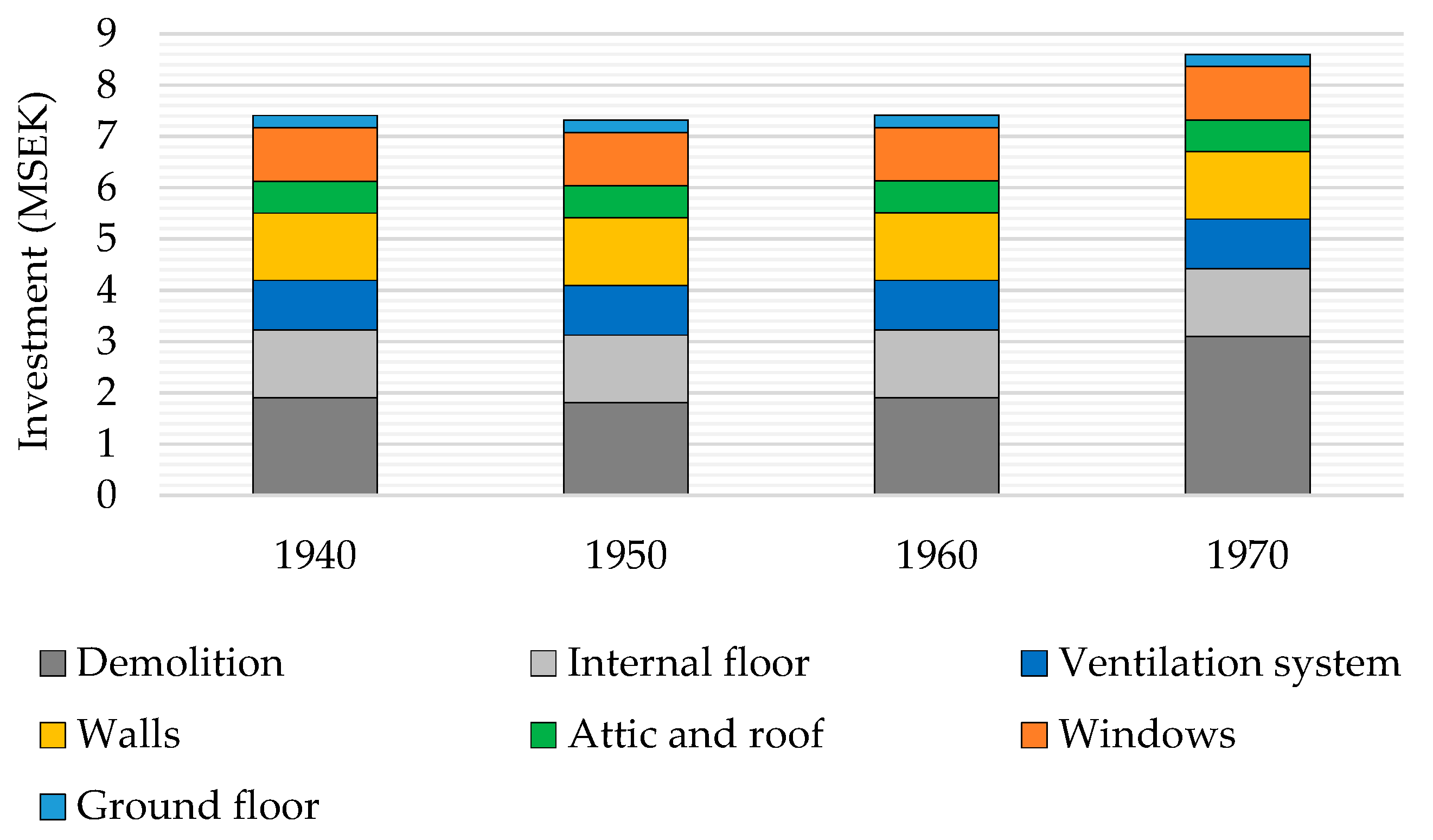
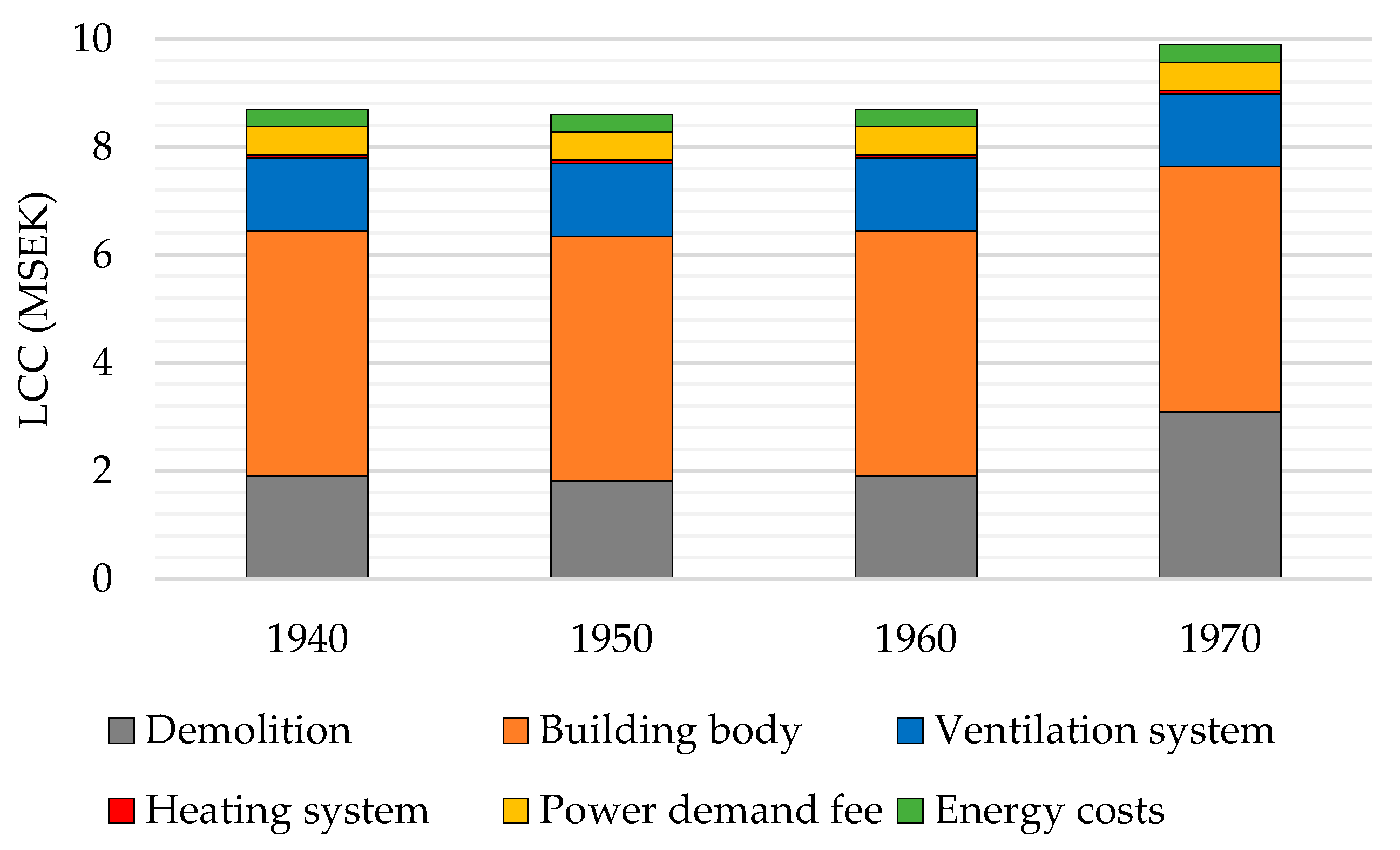
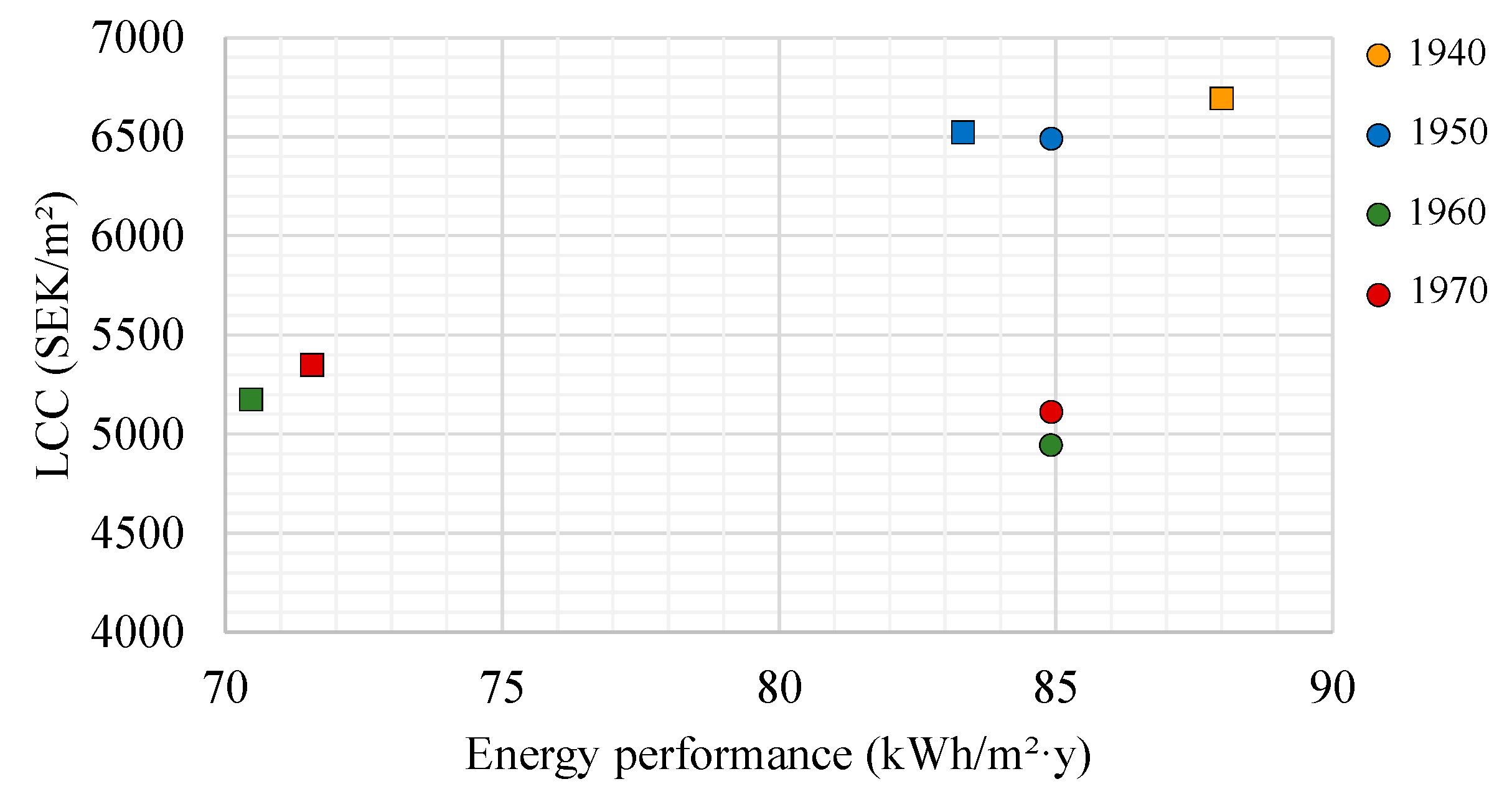

| Con-struction Year | Project Name | Extensive Demo-lition | Insu-lation of Building Envelope | New Windows | Heat Reco-very | Improved Air-Tightness | Indivi-dual Metering and CHarging | Control System | Bal-ancing Heating System | Solar COLlec-tors | Energy Use1 (kWh/m2) | Energy Renovation Cost 2 SEK3/m2 | Total Renovation Costs (SEK/m2) | Ref | |
|---|---|---|---|---|---|---|---|---|---|---|---|---|---|---|---|
| Before | After | ||||||||||||||
| 1969–1972 | Gårdssten | X | X | X | X | X | X | 263 | 145 | 2736 | 17,055 | [43] | |||
| 1971–1973 | Brogården | X | X | X | X | X | X | 177 | 58 | 7441 | 24,714 | [43,44,46] | |||
| 1971 | Katjas gata | X | X | X | X | 176 | 52 | 3986 | 19,266 | [43,47] | |||||
| 1974 | Nystad 7 | X | X | X | X | 164 | 78 | 1751 | 16,167 | [43] | |||||
| 1974 | Trond-heim 4 | X | X | X | X | 214 | 94 | 2290 | 19,670 | [43] | |||||
| Building Segment | Area (m2) | Original Construction | U-Value 1 (W/m²·°C) |
|---|---|---|---|
| External walls | 569.9 | 0.01 m plasterboard, 0.25 m lightweight concrete, cladding | 0.43 |
| Windows | 112.8 2 | three-pane | 1.9 3 |
| Floor | 216.5 | 0.2 m concrete, 0.1 m insulation Ground 4 | 0.2 |
| Attic | 194.5 | 0.05 m concrete, 0.12 m mineral wool, 0.2 m concrete | 0.25 5 |
| Building Type | Wall Construction (thickness) | Attic Construction | Window Type | Number of Floors | Number of Apartments | Ventilation System | Space Heating Demand (kWh/m2·year) |
|---|---|---|---|---|---|---|---|
| 1940s | 1½ brick wall (440 mm) | Wood beams and sawdust insulation | two-pane | 4 | 9 | Natural | 188.0 |
| 1950s | Insulated brick wall (350 mm) | Wood beams and sawdust insulation | two-pane | 4 | 9 | Natural | 157.0 |
| 1960s | Lightweight concrete (260 mm) | Insulated concrete joist | three-pane | 5 | 12 | Exhaust | 113.5 |
| 1970s | Insulated concrete cavity wall with external brick (400 mm) | Insulated concrete joist | three-pane | 5 | 12 | Exhaust | 116.2 |
| Building Segment | 1940 | 1950 | 1960 | 1970 |
|---|---|---|---|---|
| Wall U-value (W/m2·°C) | 1.03 | 0.77 | 0.45 | 0.42 |
| Attic U-value (W/m2·°C) | 0.5 | 0.5 | 0.25 | 0.25 |
| Window U-value (W/m2·°C) | 2.7 | 2.7 | 1.9 | 1.9 |
| Floor U-value (W/m2·°C) | 0.3 | 0.3 | 0.2 | 0.2 |
| Average U-value (W/m2·°C) | 0.94 | 0.79 | 0.51 | 0.50 |
| Type of Area | 1940s | 1950s | 1960s | 1970s |
|---|---|---|---|---|
| Heated area (m2) | 804.7 | 834.6 | 1072.5 | 1032.9 |
| Rentable apartment area (m2) | 683.1 | 698.9 | 918.4 | 886.2 |
| Air Exchange | 1940s | 1950s | 1960s | 1970s |
|---|---|---|---|---|
| Specific air leakage at ± 50 Pascal 1 (l/s·m2) | 0.46 | 0.46 | 0.35 | 0.35 |
| Exhaust air flow 2 (l/s·m2) | - | - | 0.58 | 0.60 |
| Natural ventilation flow1 (l/s·m2) | 0.35 | 0.35 | - | - |
| Airing (l/s·apartment) | 2 | 2 | 2 | 2 |
| Building Segment | Inevitable Renovation Measures | Energy Efficiency Measures |
|---|---|---|
| Façade | Façade cleaning and repainting of lightweight concrete structure, none for brick structure | Insulation with mineral wool, new façade plaster |
| Attic and roof | Replacement of roof tiles and repair of roof foundation | Insulation of attic with mineral wool |
| Windows | New wood framed windows with original U-value | New aluminum framed windows with U-value 1.1 or 0.8 W/m2·°C |
| Ventilation system | None | Supply and exhaust air ventilation system with heat recovery |
| Heating system | Replacement of district heating exchanger | - |
| Insulation Measures | CE1 (SEK/m2) | CE2 (SEK/m2) | CE3 (SEK/m·m2) | Thermal Conductivity (W/m·°C) | Technical Lifetime |
| Attic (max 400 mm) | 0 | 248 | 544 | 0.037 | 40 years |
| Lightweight concrete façade (max 400 mm) | 409 | 1256 | 1283 | 0.037 | 40 years |
| Brick façade (max 400 mm) | 0 | 1665 | 1283 | 0.037 | 40 years |
| Window Measures | CE1 (SEK/m2) | CE2 (SEK/m2) | CE3 | Window U-Value (W/m2·°C) | Technical Lifetime |
| Original windows1 | 7895 | 0 | - | 1.9 | 30 years |
| Window type 12 | 7895 | 441 | - | 1.1 | 40 years |
| Window type 22 | 7895 | 1367 | - | 0.8 | 40 years |
| Heating System | HS1 (SEK) | HS2 (SEK/kW) | HS3 (SEK/kW) | - | Technical Lifetime |
| District heating exchanger | 33,336 | 53 | 535 | - | 20 years3 |
| HRX Properties | 1940s | 1950s | 1960s | 1970s |
|---|---|---|---|---|
| Corresponding air exchange rate with HRX 1 | 0.47 h−1 | 0.45 h−1 | 0.51 h−1 | 0.52 h−1 |
| Cost HRX | 1.3 MSEK | 1.3 MSEK | 1.32 MSEK | 1.32 MSEK |
| Building Segment | 1940s | 1950s | 1960s | 1970s |
|---|---|---|---|---|
| Wall demolition (SEK/m2) | 1074 | 870 | 603 | 2747 |
| Demolition of joist and internal floors (SEK/m2) | 1140 | 1140 | 1140 | 1140 |
| Roof demolition (SEK/m2) | 878 | 878 | 878 | 878 |
| Window and door demolition (kSEK) | 28.5 | 28.5 | 35.4 | 35.4 |
| Building Segment | Construction | U-value | Area | Cost per m2 [49] |
|---|---|---|---|---|
| Walls | Prefabricated sandwich elements (thickness 270 mm) | 0.29 W/m2·°C | 591.6 m2 | 2310 SEK |
| Attic | 160 mm concrete 200 mm mineral wool 80 mm concreteRoof | 0.16 W/m2·°C | 194.0 m2 | 1830 SEK |
| Floor | Insulated ground slab | 0.2 W/m2·°C | 216.0 m2 | 1096 SEK |
| Windows | Three-pane, low emissivity | 0.8 W/m2·°C | 112.8 m2 | 9262 SEK |
| Internal floor | Reinforced concrete joists (thickness 300 mm) | - | 864 m2 | 1527 SEK |
| Roof | Concrete tiles of wood frame foundation | - | 344.5 m | 770 SEK |
| Other information | ||||
| Heated area | 1069.5 m2 | |||
| Rentable area | 916.0 m2 | |||
| Number of floors | 5 | |||
| Annual heat demand | 49.6 MWh | |||
| Space heat demand | 46.4 kWh/m2·year | |||
| Energy demand 1 | 84.9 kWh/m2·year | |||
| Maximum power 2 | 31.1 kW | |||
| Heat supply system | District heating | |||
| Maximal Power | Demand Fee (SEK/year) | Demand Fee (SEK/kW 1) | Heating Price Jan–Feb, Dec (SEK/kWh) | Heating Price Mar–Apr, Oct–Nov (SEK/kWh) | Heating Price May–Sep (SEK/kWh) |
|---|---|---|---|---|---|
| 5–50 kW 1 | 1200 | 931 | 0.45 | 0.32 | 0.08 |
| 51–250 kW 1 | 4700 | 856 | 0.45 | 0.32 | 0.08 |
| Renovation or Construction Characteristics | Renovation (kSEK/m2) | Demolition and New Construction (kSEK/m2) | Ref |
|---|---|---|---|
| Renovation and maintenance costs | 17.4 | - | [43] |
| Technical installations | - | 9.8 | [48] |
| Interior installations | - | 13.4 | [48] |
| Other costs | - | 2.6 | [48] |
| Rent | 0.99 | 1.23 | - |
| Time requirement | 6 months | 18 months | [48] |
| Energy Saving Target | Window U-Value (W/m²·°C) | Additional Insulation (m) | HRX | Energy Use (kWh/m2·y) | Power Demand (kW) | Reduced Heat Demand | LCC | Optimal | ||||
|---|---|---|---|---|---|---|---|---|---|---|---|---|
| North | East | South | West | Façade | Attic | |||||||
| Original | 2.7 | 2.7 | 2.7 | 2.7 | - | - | - | 188.0 | 62.0 | - | 3.08 | No |
| 10% | 1.1 | 1.1 | 1.1 | 1.1 | - | 0.02 | - | 169.3 | 55.1 | 10.0% | 2.86 | No |
| LLCC | 1.1 | 1.1 | 1.1 | 1.1 | - | 0.24 | - | 160.5 | 52.9 | 14.6% | 2.81 | Yes |
| 20% | 1.1 | 1.1 | 1.1 | 1.1 | 0.01 | - | - | 150.5 | 50.5 | 20.0% | 3.69 | No |
| 30% | 1.1 | 1.1 | 1.1 | 1.1 | 0.02 | - | - | 131.5 | 45.8 | 30.0% | 3.54 | No |
| 40% | 1.1 | 1.1 | 1.1 | 1.1 | 0.05 | - | - | 112.7 | 41.0 | 40.0% | 3.40 | No |
| 50% | 1.1 | 1.1 | 1.1 | 1.1 | 0.07 | 0.24 | - | 93.9 | 36.2 | 50.0% | 3.32 | No |
| 20%–50% | 1.1 | 1.1 | 1.1 | 1.1 | 0.16 | 0.24 | - | 76.7 | 31.7 | 59.2% | 3.24 | Yes |
| 60% | 1.1 | 1.1 | 1.1 | 1.1 | 0.18 | 0.24 | - | 75.1 | 31.2 | 60.1% | 3.24 | Yes |
| 70% | 1.1 | 0.8 | 1.1 | 1.1 | 0.26 | 0.36 | Yes | 56.3 | 26.1 | 70.0% | 4.45 | Yes |
| Max. | 0.8 | 0.8 | 0.8 | 0.8 | 0.40 | 0.40 | Yes | 48.1 | 23.9 | 74.7% | 4.57 | No |
| Energy Saving Target | Window U-Value (W/m²·°C) | Additional Insulation (m) | HRX | Energy Use (kWh/m2·y) | Power Demand (kW) | Reduced Heat Demand | LCC | Optimal | ||||
|---|---|---|---|---|---|---|---|---|---|---|---|---|
| North | East | South | West | Façade | Attic | |||||||
| Original | 2.7 | 2.7 | 2.7 | 2.7 | - | - | - | 157.0 | 56.1 | - | 2.87 | No |
| 10% | 1.1 | 1.1 | 1.1 | 1.1 | - | - | - | 141.3 | 49.9 | 10.0% | 2.68 | No |
| LLCC | 1.1 | 1.1 | 1.1 | 1.1 | - | 0.24 | - | 129.7 | 46.9 | 17.4% | 2.60 | Yes |
| 20% | 0,8 | 1.1 | 0,8 | 1.1 | - | 0.30 | - | 125.5 | 45.8 | 20.0% | 2.64 | Yes |
| 30% | 1.1 | 1.1 | 1.1 | 1.1 | 0.04 | - | - | 110.0 | 41.7 | 30.0% | 3.41 | No |
| 40% | 1.1 | 1.1 | 1.1 | 1.1 | 0.04 | 0.24 | - | 94.2 | 37.7 | 40.0% | 3.27 | No |
| 50% | 1.1 | 1.1 | 1.1 | 1.1 | 0.11 | 0.24 | - | 78.5 | 33.3 | 50.0% | 3.25 | No |
| 20%–50% | 1.1 | 1.1 | 1.1 | 1.1 | 0.16 | 0.24 | - | 72.8 | 31.7 | 53.7% | 3.23 | Yes |
| 60% | 0.8 | 1.1 | 0.8 | 0.8 | 0.26 | 0.32 | - | 62.8 | 28.9 | 60.0% | 3.31 | Yes |
| 70% | 0.8 | 1.1 | 0.8 | 0.8 | 0.30 | 0.34 | Yes | 47.0 | 24.4 | 70.0% | 4.49 | Yes |
| Max. | 0.8 | 0.8 | 0.8 | 0.8 | 0.40 | 0.40 | Yes | 44.0 | 23.7 | 72.0% | 4.56 | No |
| Energy Saving Target | Window U-Value (W/m²·°C) | Additional Insulation (m) | HRX | Energy Use (kWh/m2·y) | Power Demand (kW) | Reduced Heat Demand | LCC | Optimal | ||||
|---|---|---|---|---|---|---|---|---|---|---|---|---|
| North | East | South | West | Façade | Attic | |||||||
| Original | 1.9 | 1.9 | 1.9 | 1.9 | - | - | - | 113.5 | 57.4 | - | 3.30 | No |
| LLCC | 1.1 | 1.1 | 1.1 | 1.1 | - | - | - | 109.5 | 53.6 | 3.5% | 3.13 | Yes |
| 10% | 0.8 | 1.1 | 0.8 | 0.8 | - | 0.30 | - | 102.1 | 51.0 | 10.0% | 3.21 | Yes |
| 20% | 1.1 | 1.1 | 1.1 | 1.1 | 0.12 | - | - | 90.2 | 46.9 | 20.5% | 3.75 | Yes |
| 30% | 1.1 | 0.8 | 0.8 | 0.8 | 0.22 | 0.36 | - | 79.4 | 43.1 | 30.0% | 3.83 | Yes |
| 40% | 1.1 | 1.1 | 1.1 | 1.1 | - | - | Yes | 65.2 | 38.1 | 42.5%1 | 3.93 | Yes |
| 50% | 1.1 | 1.1 | 1.1 | 1.1 | 0.03 | - | Yes | 56.7 | 35.0 | 50.0% | 4.60 | No |
| 50% | 1.1 | 1.1 | 1.1 | 1.1 | 0.12 | - | Yes | 46.7 | 31.4 | 58.8% | 4.54 | Yes |
| 60% | 1.1 | 1.1 | 1.1 | 1.1 | 0.16 | - | Yes | 44.6 | 30.6 | 60.7% | 4.54 | Yes |
| 70% | 0.8 | 0.8 | 0.8 | 0.8 | 0.26 | 0.36 | Yes | 34.0 | 26.6 | 70.0% | 4.67 | Yes |
| Max. | 0.8 | 0.8 | 0.8 | 0.8 | 0.40 | 0.40 | Yes | 31.9 | 25.8 | 71.9% | 4.75 | No |
| Energy Saving Target | Window U-Value (W/m²·°C) | Additional Insulation (m) | HRX | Energy Use (kWh/m2·y) | Power Demand (kW) | Reduced Heat Demand | LCC | Cost Optimal | ||||
|---|---|---|---|---|---|---|---|---|---|---|---|---|
| North | East | South | West | Façade | Attic | |||||||
| Original | 1.9 | 1.9 | 1.9 | 1.9 | - | - | - | 116.2 | 56.4 | 3.04 | No | |
| LLCC | 1.1 | 1.1 | 1.1 | 1.1 | - | - | - | 112.1 | 52.6 | 3.5% | 2.86 | Yes |
| 10% | 0.8 | 1.1 | 0.8 | 1.1 | - | 0.30 | - | 104.5 | 50.1 | 10.0% | 2.94 | No |
| 20% | 1.1 | 1.1 | 1.1 | 1.1 | 0.14 | - | - | 93.0 | 46.2 | 20.0% | 3.75 | No |
| 30% | 0.8 | 0.8 | 0.8 | 0.8 | 0.22 | 0.40 | - | 81.3 | 42.4 | 30.0% | 3.86 | No |
| 10%–40% | 1.1 | 1.1 | 1.1 | 1.1 | - | - | Yes | 64.8 | 36.6 | 44.2% 1 | 3.65 | Yes |
| 50% | 1.1 | 1.1 | 1.1 | 1.1 | 0.03 | - | Yes | 58.1 | 34.3 | 50.0% | 4.57 | No |
| 50% | 1.1 | 1.1 | 1.1 | 1.1 | 0.12 | - | Yes | 47.8 | 30.7 | 58.9% | 4.52 | Yes |
| 60% | 1.1 | 1.1 | 1.1 | 1.1 | 0.16 | - | Yes | 45.8 | 30.0 | 60.6% | 4.53 | Yes |
| 70% | 0.8 | 0.8 | 0.8 | 0.8 | 0.26 | 0.40 | Yes | 34.8 | 26.0 | 70.0% | 4.66 | Yes |
| Max. | 0.8 | 0.8 | 0.8 | 0.8 | 0.40 | 0.40 | Yes | 32.5 | 25.1 | 72.1% | 4.74 | No |
| Building Type | Uaverage (W/m2·°C) | Annual Space Heating Demand (MWh) | Power Demand (kW) | Space Heating Demand 1 (kWh/m2·y) | Facility Electricity 1 (kWh/m2·y) | Domestic Hot Water 1 (kWh/m2·y) | Energy Performance 1 (kWh/m2·y) |
|---|---|---|---|---|---|---|---|
| 1940s | 0.18 | 38.7 | 23.9 | 48.1 | 14.8 | 25 | 87.9 |
| 1950s | 0.19 | 38.1 | 24.0 | 45.6 | 14.3 | 25 | 84.9 |
| 1960s | 0.29 | 49.8 | 31.3 | 46.4 | 13.5 | 25 | 84.9 |
| 1970s | 0.28 | 47.3 | 30.0 | 45.9 | 14.0 | 25 | 84.9 |
| New | 0.30 | 49.6 | 31.1 | 46.4 | 13.5 | 25 | 84.9 |
| Cost and Energy Use | 1940s | 1950s | 1960s | 1970s | ||||
|---|---|---|---|---|---|---|---|---|
| Renovate | Rebuild | Renovate | Rebuild | Renovate | Rebuild | Renovate | Rebuild | |
| LCC (MSEK) | 4.57 | 8.70 | 4.53 | 8.60 | 4.54 | 8.70 | 4.53 | 9.90 |
| LCC (SEK/m2) | 6685 | 9496 | 6485 | 9391 | 4947 | 9498 | 5114 | 10,799 |
| Renovation/construction cost (SEK/m2) | 5153 | 8147 | 4984 | 8044 | 3596 | 8150 | 3752 | 9451 |
| Energy performance (kWh/m2) | 88.0 | 84.9 | 84.9 | 84.9 | 84.9 | 84.9 | 84.9 | 84.9 |
© 2019 by the authors. Licensee MDPI, Basel, Switzerland. This article is an open access article distributed under the terms and conditions of the Creative Commons Attribution (CC BY) license (http://creativecommons.org/licenses/by/4.0/).
Share and Cite
La Fleur, L.; Rohdin, P.; Moshfegh, B. Energy Renovation versus Demolition and Construction of a New Building—A Comparative Analysis of a Swedish Multi-Family Building. Energies 2019, 12, 2218. https://doi.org/10.3390/en12112218
La Fleur L, Rohdin P, Moshfegh B. Energy Renovation versus Demolition and Construction of a New Building—A Comparative Analysis of a Swedish Multi-Family Building. Energies. 2019; 12(11):2218. https://doi.org/10.3390/en12112218
Chicago/Turabian StyleLa Fleur, Lina, Patrik Rohdin, and Bahram Moshfegh. 2019. "Energy Renovation versus Demolition and Construction of a New Building—A Comparative Analysis of a Swedish Multi-Family Building" Energies 12, no. 11: 2218. https://doi.org/10.3390/en12112218
APA StyleLa Fleur, L., Rohdin, P., & Moshfegh, B. (2019). Energy Renovation versus Demolition and Construction of a New Building—A Comparative Analysis of a Swedish Multi-Family Building. Energies, 12(11), 2218. https://doi.org/10.3390/en12112218





